Home Page
WILLIAM BOTTRELL
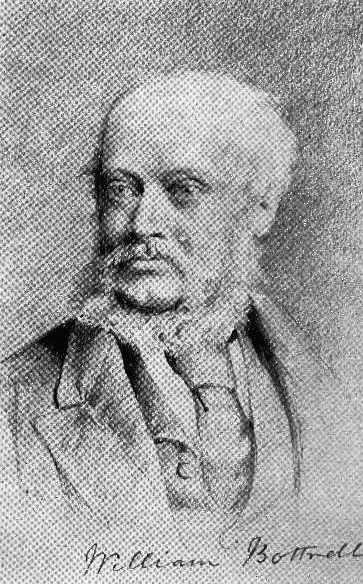
His Life and Stories.
By George Pritchard (c)
William
Bottrell was famous as a recorder of folk-tales. He wrote three volumes;
“Traditions and Hearthside Stories of West Cornwall” in 1870 & 1873 and
in 1880 “Stories and Folk-Lore of
West Cornwall”.
William
was not merely a scientific recorder of folklore. He had been brought up in an
atmosphere of chimney corner, tale telling which he was able to transfer to the
written page. His narrative has a leisurely rambling style. By the time his
tales are finished, you feel that he has told you most of the traditions,
beliefs and practices of the country folk of West Cornwall of 200 or more years
ago. Not only that but you have travelled back in time to a Cornwall before railways:
an intensely Cornish Cornwall in which you see the people going about their
daily lives and hear the Celtic rise and fall of their voices as they utter
words and phrases no longer heard today. You
have travelled back in time down a narrow winding lane of high moor-stone
hedges, topped with many an obscuring furze-bush and bramble. He has taken you
into this magic country with a glance through every gap in the hedge and a climb
over every stile. There are times that the going is rough and the guide
himself can often become tedious; but no one who has read his tales doubts
that William Bottrell knew this Cornwall and its people.
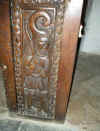
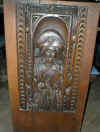
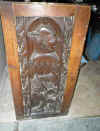
Three
Carved bench ends from St Levan Church (Click on Photo)
For
a man who became so well known towards the end of his life there is very little
in the way of written records.
On 27 March 1816,William
Bottrell was baptised in St Levan Church. He was probably born at Raftra
Farmhouse, also known as Raughtra, in St. Levan, within a couple of miles of the
Land's End. He gives his age as 69 on the 1881 census & 57 on the 1871. He
was the son of William Vingoe Bottrell and Margaret Bosence who married 12 May
1813 in Sancreed. On his father’s side William was descended from the
Bottrell, Vingoe, Hutchens & Dennis families, all ancient Cornish lines. It
is recorded that the Bottrell family can trace its line back to one Edward de
Bottreaux, whose son Sir William is alleged to have built Bottreaux Castle
c1086, now known as Boscastle.
The
Vingoe family had held their lands in the Lands-End district since time
immemorial. The same applied to William’s maternal line with both the Bosence
and the Andrew families being able to trace their roots in Cornwall back many
generations. William’s father was also born at Raftra and baptised at Sennen
in 1790. He was the son of Richard Bottrell b 1762, a yeoman farmer of Raftra
and Mary Vingoe. Mary Vingoe, William’s grandmother, was born in 1754 and
lived until 1837. She was the daughter of WilliamVingoe of Sennen and his wife
Joan Dennis. Their daughters were all baptised in Sennen but the entries are
very vague and written in the margin, almost as an afterthought. One daughter
has no parents recorded for her at all. The wills of John Vingoe, d 1760, Martin
Hitchens, d 1747 and Joan Permewan, d 1763, have filled in the missing details.
William
Vingoe was mostly concerned with the sea and boats and its possible he was off
elsewhere from time to time. His marriage to Joan Dennis I have never found,
although both are local to the area. He moved his family to Paul Parish, where
his parents and sister were also living by 1753. Here he was in sight and sound
of the sea and his business affairs in the busy port of Mousehole. Thus his
daughter Mary acquired a ready knowledge of the maritime ‘goings on’ and
perhaps she recounted her memories to grandson William, who later used them as
the basis of his tales of “The Pirate” and the many other sea stories
recorded in his writings. There are also family associations with Ailsa Mill,
Kemyel Cliff and Burnwhal, all location settings for his various cautionary
tales.
Young
William Bottrell’s father was a yeoman farmer of some means, so the first few
years of his life were spent on the family farm at Raftra. It was in these
surroundings that he must have heard his first stories, perhaps whilst sitting
by the fire in the big kitchen with his grandparents. His grandmother must have
told him how, as a young girl, she had been sent to live with her recently
married aunt and uncle in Penzance. This was her mother’s sister, Grace
Dennis, who in 1767 had married Francis Boase, an affluent farmer and butcher
from Alverton. They later had several sons, who rose to some prominence in
Penzance as both mayors and bankers. However, having no companions her own age
in this household, Mary age 13 had befriended the young and boisterous Edward
Pellew who was living in the nearby ‘Hawke Farmhouse’ with his widowed
mother. Edward and his brother Israel Pellew were later to achieve naval fame
and Edward was to become Admiral Lord Exmouth. Bottrell tells this story in
volume three of his folktales.
Apparently
grandma Mary must have had a great influence on young William. I believe he must
have spent much time with her as they walked through the cliff- top fields and
down to the little beaches by the shore, she telling him stories that had been
handed down from generation to generation over hundreds of years; stories that
were later to become the basis of his writing. She also must
have imparted to him her knowledge of herbal and medicinal plants,
together with their habits and requirements. He was later to establish a garden
at Hawke’s Point that visitors would wander at created from some scrubby
moorland.
William
was an only child so his parents were able to give him undivided attention and a
good education. This started with his attendance at Penzance Grammar School
under two local teachers of repute; William Purchase, who was the English master
there, and later a Nicholas Bice Julyan. In 1831 he was sent to further his
education at Bodmin School where the headmastership was one Leonard James Boor.
Here William gained a love of the classics and mathematics, which stayed with
him for the rest of his life. He left Bodmin School in 1837 and little is known
of his life between 1837 and 1851, other than, like so many of his fellow
Cornishmen he travelled the world. His beloved grandmother Mary had died in the
April of 1837 and it is believed that soon
after this he visited France and went on to buy land in the Basque area of
Spain. Later in his life he used to speak of his love for his Spanish garden
with its herbs, fruit and flowers. He also collected Breton and Basque folk
tales. His idyll came to an abrupt end when his land was seized and returned to
the Catholic Church, from whom it had been initially confiscated by the
authorities. Bottrell returned to Cornwall a financially ruined man, as he had
received no compensation.
His
mother Margaret died in October of 1845 age 53 and within months William was on
the move again, this time to Canada. He eventually obtained a position as an
English Teacher at a college in Quebec (1847-1851). He became unsettled with
academic life though and left for the forests of the interior, where he worked
for a short time as an overseer in a timber company. Eventually, in 1852 he came
home to Penzance and lived at No. 4, St Clare Street.
At
some stage he is believed to have married and he and his wife went to live in
Australia where she died. This was a black time in his life, which he refused
ever to discuss with anyone. He would dismiss it with the words ‘I lost my
love and my money so I came home.’ He had many relatives in Australia, some of
whom are listed as subscribers in the back of his books, but I have failed to
discover any greater details as regards this bleak episode in his life.
I also think that at some point there was a major split between father and son.
On
the death of his wife in 1845, and with his son William gone overseas it looks
as if William senior then in his late 50’s, sold up the farm at Raughtra and
moved into Penzance. Leastways, he is not in St Levan on 1851 census. In January
of 1854, at the age of 65, he married Elizabeth Howe, only six years older than
his son. When young William returned in 1853 did he find out that his father had
sold the old home and was planning to marry again? Perhaps when he did marry and
then in 1855 christened his new daughter Wilhelmina [the German feminine form of
the name William] this was all too much for his son. One wonders perhaps by
naming his daughter thus, William senior had entirely disowned his only son.
William
Bottrell senior died at Hea Villas, Penzance and was buried in St Levan on 24
Dec 1875 aged 86. On the 1881 Census his widow age 61 and daughter age 26 are
living in Devon on ‘an income from Railway Bonds’.
 Although
estranged from his father and now a widower it is believed William must have
returned from Australia in the early 1860’s. He lived the life of a recluse at
Hawke's Point near Lelant. A friend of his was to later write:
“Here
he lived in a hovel and cultivated a little moorland. He had a black cat called
‘Spriggans’ plus a cow and pony. These animals would all follow him down the
almost perpendicular cliff, over a goats path, to the spring which was their
water supply and no accidents happened to either."
Although
estranged from his father and now a widower it is believed William must have
returned from Australia in the early 1860’s. He lived the life of a recluse at
Hawke's Point near Lelant. A friend of his was to later write:
“Here
he lived in a hovel and cultivated a little moorland. He had a black cat called
‘Spriggans’ plus a cow and pony. These animals would all follow him down the
almost perpendicular cliff, over a goats path, to the spring which was their
water supply and no accidents happened to either."
He
went on to tell how Bottrell became a friend of the tinners who worked in the
near-by mines. They would do a days work underground then think nothing of
spending a couple of hours helping Bottrell clear ground in order that he could
create a garden. It was from these men that Bottrell learned more of the ancient
tales of West Penwith. As they sat by the fire in the cottage which he had made
his home, one of the number would tell a tale whilst William drew a sketch of
the man. Bottrell always acknowledged the debt he owed to these men, he said of
them "they have intelligence, mother-wit and memories and I am able to
garner from them the ample harvest."
The subsequent loss of the wondering ‘droll tellers’ meant that, but for the
work of William Bottrell, recorded in his own volumes and in those of Robert
Hunt, most of their stories would have been lost. Bottrell had recounted many of
the tales he knew to Robert Hunt, who had utilised them in his own work
“Popular Romances of the West of England”, which was first printed in 1865.
In excess of 50 ‘drolls’ were told by Bottrell to Hunt. who had received
much acclaim for his work. He had acknowledged his debt to Bottrell and others
for recounting their stories to him, but perhaps he had been less than honest in
his intentions when collecting them.
Others
were soon to realise the wealth of knowledge that Bottrell possessed and the
editor of a local paper suggested that he should write and publish the stories
in his own rite. Bottrell took his advice and his first appearance in print was
in the columns of ‘The Cornish Telegraph’ of 1867, in which he gave an
account of "The Penzance of our Grandfathers" which was reprinted in
volume one of his subsequent books. His
articles appeared also in "One and All", a particularly interesting
and now rare periodical and in 1873 he contributed to another magazine now a
collectors item, the "Reliquary".
Of
all these various articles the best were gathered together and published and
life began to improve for William. By 1871 he was living in lodgings in Penzance
but he later moved into a relative’s home in Dove Street, St Ives but before
the completion of his final volume he had a stroke and suffered a partial
paralysis. He was still able to speak and, although bed bound for almost a year,
he continued to dictate his regular column to the newspaper.
A
further stroke in May 1881 led to a more acute paralysis. His cousin, Mary
Quick, continued to take care of him but after six weeks of struggling against
the odds he gave up the ghost at 10am on the 27 August 1881.
He
was taken back to be buried
on 31-Aug-1881
near the place he loved the most. He lies in St. Levan, amongst his ancestors,
in the little churchyard that overlooks the sea.
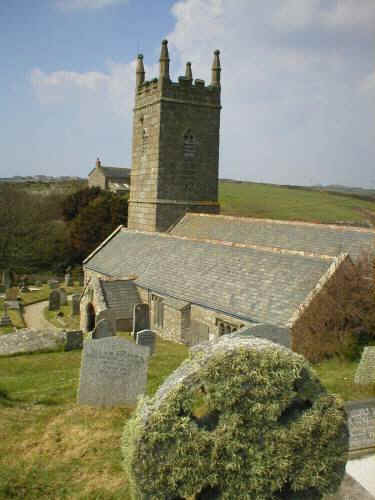
0-0-0-0-0-0-0-0
To follow this thread go HERE -
Return to the TRIBAL
TREE
Home Page
Questions or problems regarding this web site should be directed to george@penhalvean.freeserve.co.uk
Last modified: Sunday October 22, 2006.






 Although
estranged from his father and now a widower it is believed William must have
returned from Australia in the early 1860’s. He lived the life of a recluse at
Hawke's Point near Lelant. A friend of his was to later write:
Although
estranged from his father and now a widower it is believed William must have
returned from Australia in the early 1860’s. He lived the life of a recluse at
Hawke's Point near Lelant. A friend of his was to later write: